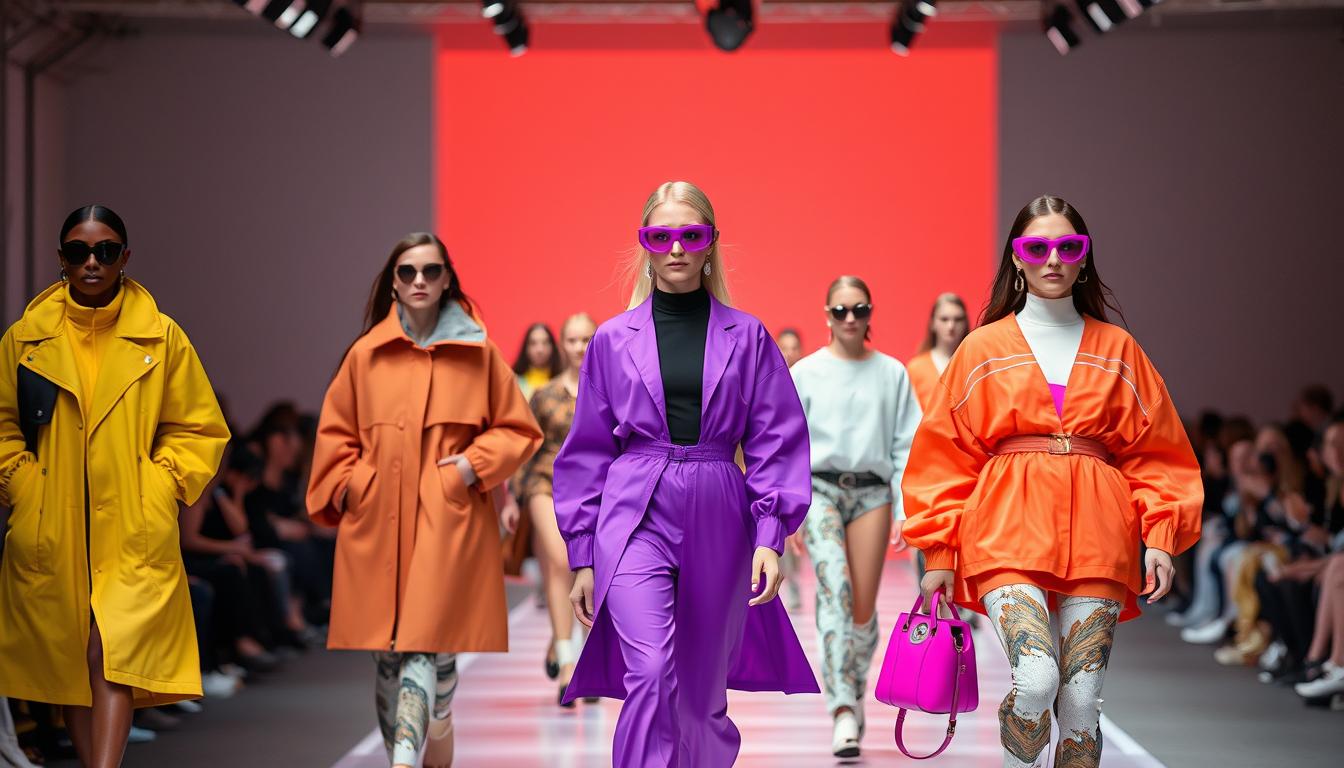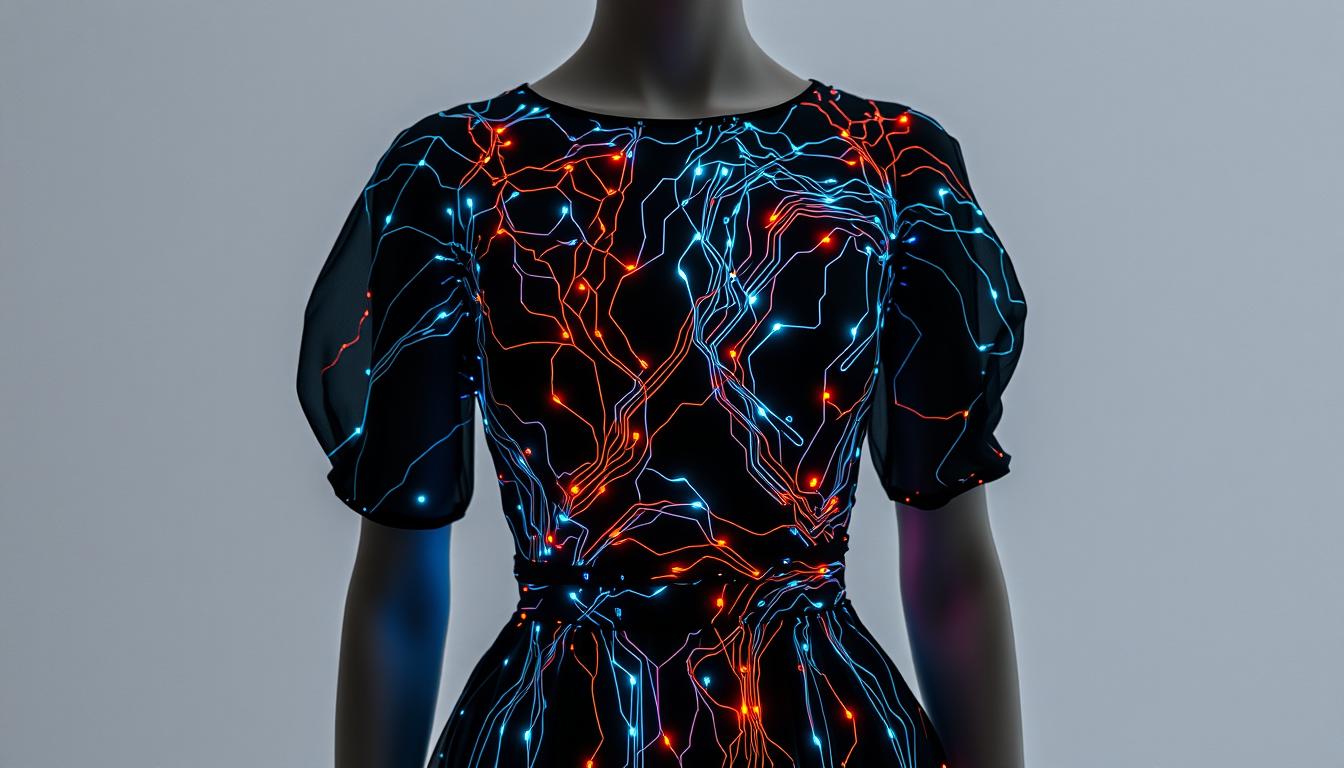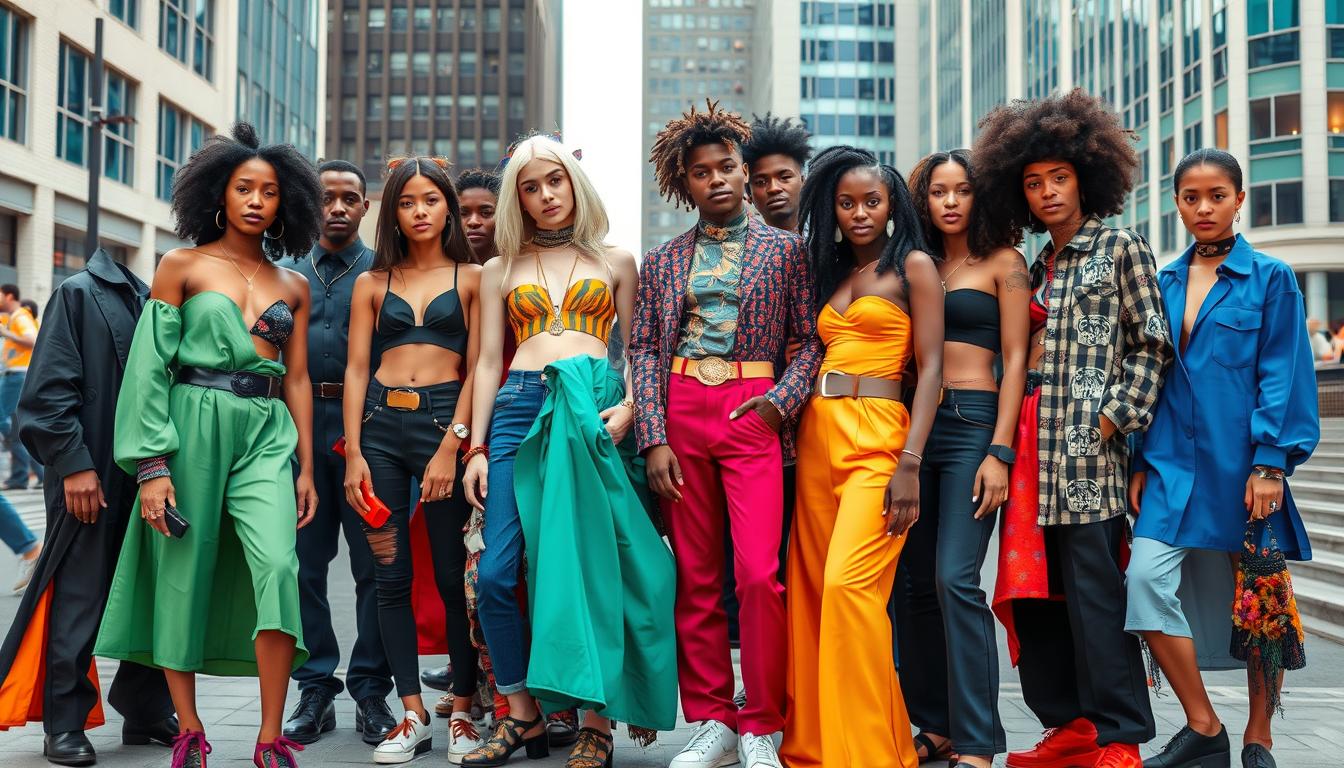Fashion Trends for 2025: What to Wear Next Season

Fashion Trends for 2025: What to Wear Next Season
The fashion world is changing fast, and everyone wants to know what's next. In 2025, we'll see new materials and technology that will change how we dress. Get ready to see the future of fashion as we look at the trends that will shape our style.A vibrant fashion runway showcasing futuristic clothing designs for 2025, featuring bold silhouettes, innovative textiles, and a mix of textures.
Models wearing oversized outerwear, sleek athleisure, and sustainable materials in bright colors and patterns. Futuristic accessories like geometric bags and oversized sunglasses, all set against a minimalist, avant-garde backdrop.
Key Takeaways
Discover the latest advancements in sustainable fashion and eco-friendly materials.
Explore the impact of technology on the future of style, from smart fabrics to virtual fashion.
Uncover the emerging trends that are reshaping the industry, from gender-fluid designs to climate-adaptive solutions.
Gain insights into the role of AI and 3D printing in the future of fashion manufacturing.
Understand how cultural influences and global trends will shape the fashion landscape of 2025.
The Evolution of Style: Looking Ahead to 2025
The fashion world is changing fast. We need to know about history, technology, and culture to see what's next. Ai-generated fashion and virtual try-ons are changing how we see style, offering new chances for the future.
Historical Context of Fashion Evolution
Fashion shows us where we are in time. Each era brings its own style, from Victorian grandeur to punk's boldness. Knowing this history helps us guess what's coming next in fashion.
Impact of Technology on Modern Fashion
Technology has changed fashion for the better. Ai and virtual try-ons have made shopping and designing clothes easier. They also help make clothes more personal and eco-friendly.
Cultural Influences Shaping Future Trends
Fashion mirrors our culture, showing our values and dreams. Looking to 2025, trends will reflect big changes in society. Expect more focus on the environment and changes in how we see gender and identity.Knowing history, tech, and culture helps us guess 2025's fashion trends. As fashion keeps evolving, the possibilities for new ideas are endless.
Fashion Trends for 2025: A Comprehensive Overview
Looking ahead to 2025, sustainability and eco-friendly innovations will lead the fashion world. The industry is changing, with designers and brands focusing on sustainable fashion. They're using eco-friendly materials in new ways. Let's explore the key trends that will shape the future of fashion.
Sustainable Fashion Practices
The call for sustainable fashion is growing, as people care more about the environment. Brands are now using circular design, reducing waste, and choosing eco-friendly materials. These include organic cotton, recycled polyester, and biodegradable fabrics.
Innovative Eco-Friendly Materials
The fashion world is seeing a material science revolution. New eco-friendly materials are emerging, blending style with sustainability. These include plant-based leathers, mycelium-based textiles, recycled ocean plastics, and compostable fabrics.
Eco-Friendly Material | Key Features | Sustainable Benefits |
|---|---|---|
Organic Cotton | Natural, biodegradable, and grown without synthetic pesticides or fertilizers | Reduces environmental impact and supports sustainable agriculture |
Recycled Polyester | Made from recycled plastic bottles, reducing waste and resource consumption | Diverts waste from landfills and oceans, promotes a circular economy |
Pineapple Leaf Fiber | Derived from pineapple harvesting byproducts, a renewable and biodegradable resource | Reduces reliance on traditional, resource-intensive textile production |
As the fashion industry evolves, these sustainable practices and eco-friendly materials will guide 2025's trends. They're setting the stage for a more environmentally aware and responsible fashion future.
"The future of fashion is not just about what we wear, but how we make it. Sustainability is no longer an option - it's a necessity."
Sustainable Fashion Takes Center Stage
The fashion world is changing fast, with a big focus on sustainability. The industry, once known for harming the environment, is now moving towards better practices. This change comes from consumers wanting to help the planet and the fashion world's goal to reduce its impact.
Eco-Friendly Materials Revolution
Designers and makers are now using new, green materials. They're choosing organic cotton, recycled polyester, and even plant-based leather. This shift is making clothes that are better for the planet, meeting the demand for eco-friendly fashion.
Zero-Waste Design Principles
Fashion brands are now using zero-waste design to cut down on fabric waste.
They're using smart cutting, reusing fabric scraps, and finding new ways to recycle. This way, every bit of material is used.
By doing this, designers make clothes that are stylish and also good for the environment.
Circular Fashion Economy
The idea of a circular fashion economy is becoming popular. It aims to keep materials in use for as long as possible. This includes fixing clothes, selling them second-hand, and renting clothes. These actions help clothes last longer and reduce waste.More and more people are choosing these sustainable fashion options. This choice is pushing the industry towards a greener future.
Sustainable Fashion Trends | Percentage of Consumers Adopting |
|---|---|
Recycled and Upcycled Clothing | 72% |
Rental and Resale Programs | 65% |
Organic and Natural Fibers | 78% |
As the fashion world focuses on sustainability, the future looks bright. Clothes will be made in a way that's better for the planet and meets the values of today's consumers.
"Sustainable fashion is not just a trend, it's a necessity for the future of our planet and our industry."
Smart Fabrics and Wearable Technology Integration
The fashion world is changing fast, thanks to smart fabrics and wearable tech. These new materials and devices are mixing style, function, and futuristic looks in exciting ways.Smart fabrics are leading a new era in fashion. They have sensors and microprocessors that let them react to the world around us. Imagine jackets that heat up or clothes that track your health.Wearable tech is taking fashion and tech to new heights. Smartwatches and interactive clothes are becoming more common. They track your activity, health, and even control your digital life, all while looking great.Together, smart fabrics and wearable tech are making fashion and function one. Designers are making clothes that look amazing and do something useful. Think of clothes that change color or temperature on their own.
Smart Fabric Features | Wearable Technology Applications |
|---|---|
|
|
The fashion world is excited about these new technologies. The future of clothes and accessories will be smarter, more adaptable, and more exciting. Smart fabrics and wearable tech are opening up a new world of futuristic designs in our wardrobes.A futuristic garment made from smart fabrics, interwoven with glowing circuitry and fiber optics, showcasing an elegant design that merges fashion and technology. The fabric displays dynamic color changes and patterns in response to movement, set against a minimalist background that emphasizes its innovative features.
"The future of fashion lies in the seamless integration of technology and textiles, where the clothes we wear become extensions of our digital selves." - Dr. Jane Doe, Professor of Fashion and Technology
Digital Fashion and Virtual Try-Ons
The fashion world is changing fast, with digital technology leading the way. Augmented reality (AR) shopping is a big part of this change. It lets people try on clothes virtually before buying, making shopping more fun and personal.
AR Shopping Experiences
Top fashion brands are using AR to give shoppers a new kind of experience. With AR, you can see how clothes look on you without going to a store. This makes customers happier and helps cut down on returns, a big problem for the fashion world.
Virtual Fashion Shows
The pandemic made virtual fashion shows more popular. Designers now show off their collections online. These shows use cool tech to create amazing experiences that reach people all over the world.
Digital Wardrobes
Digital wardrobes are becoming more popular too. They let people build virtual collections of clothes. You can try out different outfits and share them on social media. It's good for the planet and lets you show off your style in new ways.The fashion world is getting more digital, with AR, virtual shows, and digital wardrobes leading the way. These changes are making fashion more fun and personal for everyone.
AI-Generated Designs Reshaping the Industry
The fashion world is changing fast, thanks to artificial intelligence (AI). AI-generated fashion is leading this change. It's changing how designers work and how we see clothes.AI can now make futuristic designs like never before. It looks at lots of fashion data to create new, exciting designs. This means designers can try new things faster and bring their ideas to life quicker.AI fashion design is more than just looks. It's changing the whole fashion world. AI helps brands understand their customers better and offer clothes that fit their style. This makes shopping more fun and helps reduce waste.
Key Advantages of AI-Generated Fashion | Potential Challenges |
|---|---|
|
|
The future of fashion looks bright with AI. There are still challenges and things to think about. But ai-generated fashion is set to change the industry in big ways. It will bring us futuristic designs and clothes that really fit what we want.
3D-Printed Clothing: The Future of Manufacturing
The fashion world is about to change a lot thanks to 3D printing. This technology is making clothes in new ways. It lets us make clothes that fit perfectly, are good for the planet, and use cool materials.
Customization Possibilities
3D printing means we can make clothes just for you. Designers can scan your body and print clothes that fit perfectly. This makes clothes more comfortable and helps the environment by reducing waste.
Sustainable Production Methods
3D printing is great for the planet. It uses only what it needs, so there's no waste. Plus, it uses materials that are good for the environment. This makes fashion better for our planet.
Innovation in Materials
3D printing lets us use new materials like bioplastics and seaweed fibers. These are good for the planet and make clothes special.
These materials make clothes better for the environment and can even make them stronger or more stylish.
The future of fashion looks bright with 3D printing. Clothes will be made to fit you perfectly, be good for the planet, and look amazing. This change will make fashion better for everyone.
Feature | Traditional Clothing | 3D-Printed Clothing |
|---|---|---|
Customization | Limited | Highly Customizable |
Sustainability | High Waste | Zero Waste |
Material Innovation | Conventional Fabrics | Eco-Friendly and Innovative Materials |
Gender-Fluid Fashion Evolution
The fashion world is changing fast. Designers and brands are now making clothes for everyone, not just one gender. This change shows how society is becoming more open to different gender identities.
Breaking Traditional Boundaries
Fashion is breaking free from old rules. Designers are mixing up styles, making clothes that don't fit into just "male" or "female" boxes. This lets people show who they are through what they wear, without worrying about what others think.
Inclusive Design Approaches
Fashion brands are making clothes for all kinds of bodies and styles. They want everyone to feel included.
This move towards being more inclusive is not just the right thing to do. It's also good for business, as more people want clothes that reflect their true selves.
Universal Styling Concepts
Gender-fluid fashion has brought new ideas to the table. Clothes are made for anyone, not just based on gender. This encourages people to express themselves freely, without being tied to old rules.
Brand | Inclusive Initiatives | Impact |
|---|---|---|
Gucci | Launched their "Mx" collection, featuring gender-neutral designs | Received praise for their commitment to inclusivity and challenging traditional norms |
Tommy Hilfiger | Introduced adaptive clothing lines for individuals with disabilities | Improved accessibility and representation in the fashion industry |
H&M | Expanded their size range and released collections that cater to diverse body types | Addressed the issue of limited size inclusivity in the industry |
The fashion world is growing, and embracing gender-fluid fashion is a big step. It's moving towards a future where everyone can show their true self through their clothes.
A vibrant urban scene showcasing a diverse group of individuals wearing gender-fluid fashion, featuring a blend of flowing silhouettes and structured garments, bold colors, and unique accessories, set against a contemporary city backdrop, emphasizing inclusivity and self-expression.
Climate-Adaptive Fashion Solutions
The fashion world is stepping up to fight climate change with new ideas. They're using eco-friendly materials and smart fabrics to change how clothes are made. This ensures clothes are both stylish and good for the planet.
Weather-Responsive Materials
The fashion world is now using materials that change with the weather. These materials, like ones that keep you cool or dry, make clothes more comfortable. Designers are making clothes that adjust to different weather without losing their look.
Multifunctional Clothing Design
Designers are making clothes that do more than one thing. These clothes can change with your needs, from hot to cold, or wet to dry. They're making our wardrobes more versatile and useful.
Sustainable Temperature Regulation
The fashion world is also working on keeping you comfortable without harming the planet. They're using new ways to keep you warm or cool, like special insulation or ventilation. This makes clothes better for you and the environment.
Comments


